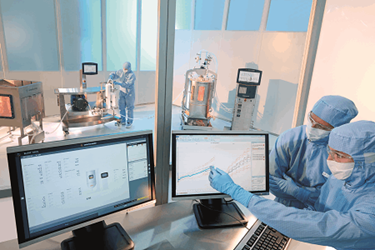An Introduction To Analytical Instrument Qualification & Validation — Meeting FDA Expectations
By Joy McElroy

According to the FDA and other regulatory agencies, analytical instruments should be under the same strict control as manufacturing equipment. Analytical instruments provide critical scientific data about a manufactured product. This data ensures confidence that a quality product has been manufactured and is appropriate and safe for sale to the public. Therefore, as manufacturers, we are bound to ensuring all of our equipment is strictly controlled. Analytical instruments must be qualified, just as manufacturing equipment. We have to show consistency, reliability, and repeatability to ensure the quality of the drugs we produce. The FDA's findings of deficiencies concerning analytical instrument qualification indicate it expects definitive evidence that instrument qualification schedules satisfactorily control manufacturing processes as well as testing processes.
Cost Of Noncompliance
Failing to qualify analytical instruments brings the quality of the manufactured product into question. Decisions made to release product become questionable. And, the fact the manufactured product was tested without guaranteed confidence brings into question if the product is substandard or perhaps even adulterated.
A product being deemed adulterated will result in a recall and a huge cost to the manufacturer from lost revenue. It will also result in regulatory audits, observations, citations, 483s, warning letters, and perhaps even a consent decree with possible criminal prosecutions. All of this can cost the manufacturer millions of dollars. Known costs have been as high as $500 million, with $250 million in lost sales. This does not include the millions that may have to be paid out in civil lawsuits as a result of harm or injury to consumers. The costs of civil litigation can be north of $10 million.
Required Documentation For Analytical Instrument Qualification
The validation master plan is a tool for planning validation projects. It is documented evidence of what is needed to carry out validations, providing information on necessary resources and input into scheduling. The validation master plan should include an overall assessment of the possible impact of the manufacturing processes, all equipment and analytical instruments to be qualified, all processes to be validated, and a definition of products and process flows. The validation master plan considers protocols and specifications. It also mandates the methods for continuous monitoring of processes, equipment, and analytical instruments.
The FDA and other regulatory agencies require manufacturers to have sound, stringent protocols for qualifying analytical instruments as well as manufacturing equipment. There are four main qualification protocols, outlined below.

Are you in compliance with the FDA regulations for equipment qualification and validation in your manufacturing facility? Get expert advice directly from Joy in her webinar:
FDA Regulations for Analytical Instrument Qualification and Validation: Comprehensive Best Practices
Design Qualification (DQ)
The DQ defines the functional and operational specifications of the analytical instrument. User requirements are contained within this protocol and must define every requirement relating to safety, identity, strength, purity, and quality of the product. The DQ should detail all decisions made in selecting the supplier. It will ensure instruments have all necessary functions and performance criteria to be successfully implemented for the intended purpose.
Installation Qualification (IQ)
The purpose of the IQ is to ensure all aspects of the facility, equipment, and instruments are installed correctly and comply with the original design and user requirements. The IQ ensures the instrument is received as designed and specified and is properly installed in the correct environment and that the environment is suitable for proper use of the instrument. The IQ should ensure all components are identified and verified against the manufacturer’s specifications.
Operational Qualification (OQ)
The OQ is documented evidence that the system functions to meet design specifications. Each of the instrument’s functions are checked to make sure they conform to the instrument manufacturer’s specifications. Guidelines stress the importance of instrument qualification simulating actual testing conditions, including worst-case situations, and that "tests and challenges should be repeated a sufficient number of times to assure reliable and meaningful results." There are no specific numbers of runs for analytical instrument qualifications, but multiple tests to simulate actual testing parameters and establish consistency are expected.
Performance Qualification (PQ)
PQ is the process of demonstrating an instrument consistently performs according to specifications appropriate for its routine use. Consistency is important in PQ. The test frequency is much higher than in the OQ. Another difference in the PQ is it should always be performed under conditions simulating routine sample analysis.
Types Of Analytical Instrument Qualifications
There are three types of analytical instrument qualifications. The first and most common is the prospective qualification. The prospective qualification is performed on new instruments. It is carried out before a product has been tested on the instrument. It can also be carried out when a significant change to the instrument or analysis has been made that may affect the analytical results. Prospective qualifications may also occur when a new product analysis is required that differs from the existing process.
The next type of analytical instrument qualification is concurrent qualification.
The third type of analytical instrument qualification is retrospective qualification. This is for a product already being marketed and is based on extensive historical data accumulated over several lots and over time. Some essential elements of retrospective analytical instrument qualification are:
- analysis has been carried out for a defined period of time on a product manufactured for a defined period of time
- master manufacturing documents
- analytical testing documents
- batch size/strength/manufacturer/year
- current specifications for the analytical method
- list of process deviations, corrective actions, and changes to manufacturing and testing documents
- data for stability testing for several batches
- trend analysis, including those for quality-related complaints.
Retrospective instrument qualification is used for analytical instruments in operational use that have not undergone a formally documented qualification process. Qualification of these instruments is possible using historical data to provide the necessary documentary evidence that the analytical instrument does what it is believed to do.
Developing A Successful Implementation Plan
Successful analytical instrument qualification plans can be implemented following these suggestions for the validation master plan, user requirements, the DQ/IQ/OQ/PQ protocols, and carrying out the proper qualification. However, the final step to consider is requalification. Confidence is retained by requalifying equipment at regular intervals. While the IQ is omitted from requalification, requalification should be performed at regular intervals (every two, three, or five years). Requalification for analytical instruments that have critical applications should be performed at least annually. While not a regulatory requirement, implementing a regular requalification plan establishes a quality-conscious environment in a manufacturing organization.
Analytical instruments can provide a high level of confidence in the integrity and quality of the manufactured product through scientific data, and that confidence can only be achieved through proper instrument qualification. Failing to qualify analytical instruments may lead to the product being considered adulterated and costing the manufacturer millions of dollars. Developing a validation master plan that truly represents the entire validation lifecycle, implementing stringent analytical equipment qualification programs, maintaining up-to-date standard operating procedures, writing and enforcing strong qualification protocols, and initiating a regular requalification program demonstrates stringent control over manufactured products. This assures the FDA and other regulatory agencies that your company has a commitment to manufacturing quality products.
Photo credit: Top/feature image courtesy of Sartorius
About The Author:
 Joy McElroy is the founder and principal consultant at Maynard Consulting Company, which provides services in validation engineering, process engineering, quality control, and quality assurance. McElroy began her career in the pharmaceutical industry performing environmental monitoring and sterility testing, and then moved into a supervisory role overseeing quality control. From there, she moved into quality assurance, and then into equipment qualification and process validation. In addition to consulting, she also develops and delivers webinars, on-site training, and seminars in areas such as technical writing, equipment qualification, cleaning validation, FDA audit preparation, and more.
Joy McElroy is the founder and principal consultant at Maynard Consulting Company, which provides services in validation engineering, process engineering, quality control, and quality assurance. McElroy began her career in the pharmaceutical industry performing environmental monitoring and sterility testing, and then moved into a supervisory role overseeing quality control. From there, she moved into quality assurance, and then into equipment qualification and process validation. In addition to consulting, she also develops and delivers webinars, on-site training, and seminars in areas such as technical writing, equipment qualification, cleaning validation, FDA audit preparation, and more.
McElroy earned her B.S. in zoology from North Carolina State University. You can reach her at joy@maynardconsultingcompany.com or connect with her on Linkedin.
